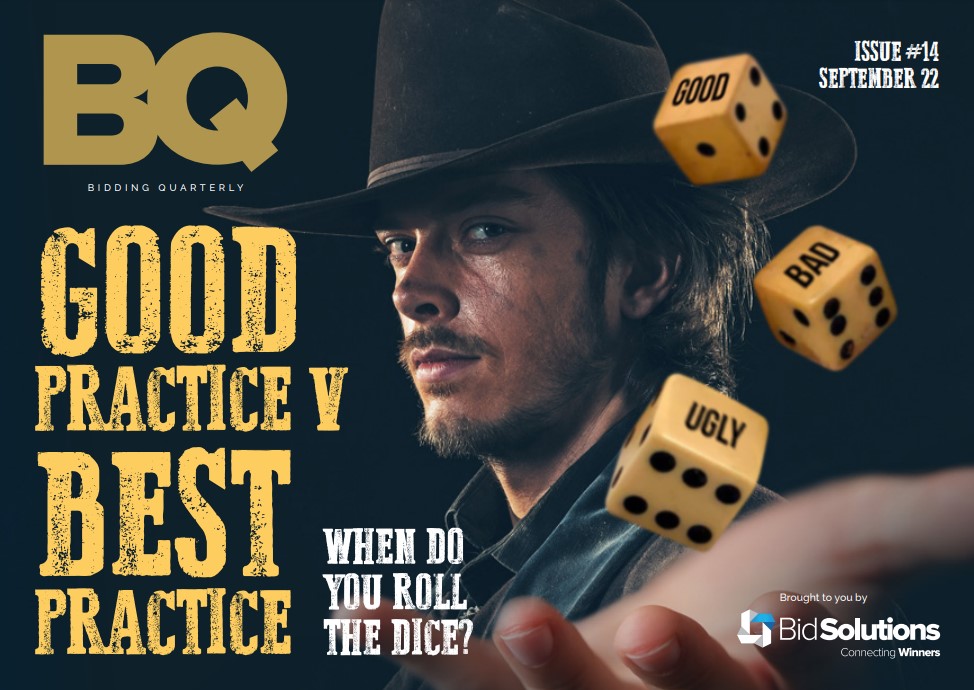
What is best practice, and does it even exist?
I suppose most people would say best practice means doing things according to agreed quality standards. But…we do know time and deadlines get in the way of best practice and it is not always possible to follow a quality process each and every time we submit a proposal.
Anyone in this business long enough will tell you to have a draft executive summary at the beginning of the proposal process to give everyone a steer in the direction of the winning strategy. Many people are religious about this and do it. Many only do it at the end. Are they breaking the unspoken rules of best practice? I know excellent proposal professionals who admit they don’t always do it at the beginning but get great results anyway.
In this article, I will argue that best practice cannot stand still because if it did, mediocrity would be the eventual result. “What???”, I hear you saying. Surely best practice means the best way of doing things, so how can I call it mediocre?
Well, think about it. If everyone – and I mean all of us and all of our competitors – were following best practice to the letter in any given profession, the results would be a sea of vanilla or penguin[1] proposals. We would all be submitting monochrome proposals indistinguishable from any other. They would all look and feel the same. No one would stand out against the competition.
So I’d like to propose an alternative way to look at best practice. What if we called it ‘next practice’?
Surely best practice would be something that makes your proposal distinct from your competitors or from the norm. Something that makes you think, “This feels unique”. My point is people often confuse best practice with a standard, “something used as a measure, norm, or model in comparative evaluations”[2]. Standards are the minimum necessary to consider something sufficiently acceptable and fit for purpose. Best practice, therefore, tends to be something that meets a ‘minimum’ acceptable standard and is the benchmark for a particular industry.
My argument is best practice is not what the majority in an industry does. Best practice includes all the approaches and innovations delivered on top of the minimum standards for a particular industry.
Let me give you a practical example from the world of bids and proposals.
As proposal professionals, we all know the importance of winning with each and every submission we send to a customer. In our industry, it may be called best practice to have a set of win themes and win strategies repeated throughout the document to persuade the client to choose us. You may say these themes and strategies are necessary for success.
Then someone clever like Eve Upton[3] (thank you Eve!) produces an alternative way of being a winner by turning win strategies upside-down and focusing instead on ‘how not to lose’. She calls this technique ‘Pre-mortem’. Rather than sitting at the end of a bid process listing all the things that went wrong in a bid submission (a well-known best practice called Lessons Learned Review), a proposal team would do this at the planning stage and anticipate anything that may go wrong at the start of the bidding process. This approach is a way of planning for the worst so that we cannot lose.
If you ask me, this is an example of ‘next practice’. Something that turns the status quo (best practice) on its head and innovates a methodology to do it better.
To go back to Martin’s original question: “What does best practice actually mean to you?”
For me, best practice is a process of continuous innovation. I don’t think it is a tried and tested process, an external benchmark, or a set of standards everyone in the business adheres to. Best practice for me is when you deliver the best possible experience for your customer and your team while breaking new ground at the same time. Continuous improvement, trying new processes and methods, and being adventurous is what brings us progress.
Certainly in bid management, as in other fields, best practice is not a way to keep the status quo. Spreading best practice is to be brave, try new approaches or completely subvert the way things are done.
So next time you are working on a bid, be more like Eve. Be daring and be the one who leads the rest of the industry – not with best practice but with ‘next practice’.
[1] Credit to Jon Williams of Strategic Proposals for the term ‘penguin proposal’. I first heard it in one of his training sessions to describe proposals that all look the same.
[2] Oxford Languages
[3] https://academy.bidcraft.co.uk/courses/pre-mortems
This article was written by Rita Mascia.
Rita’s journey into the world of bids and proposal started while working for an award-winning language and culture business organisation. Rita is a bid professional with 21 years of experience in the public, private and not for profit sectors. Her expertise in the bid cycle includes business development, capture, bid management, bid writing, and contract negotiations. Her passion lies in leading teams to win business by producing persuasive proposals that deliver what they promise.

